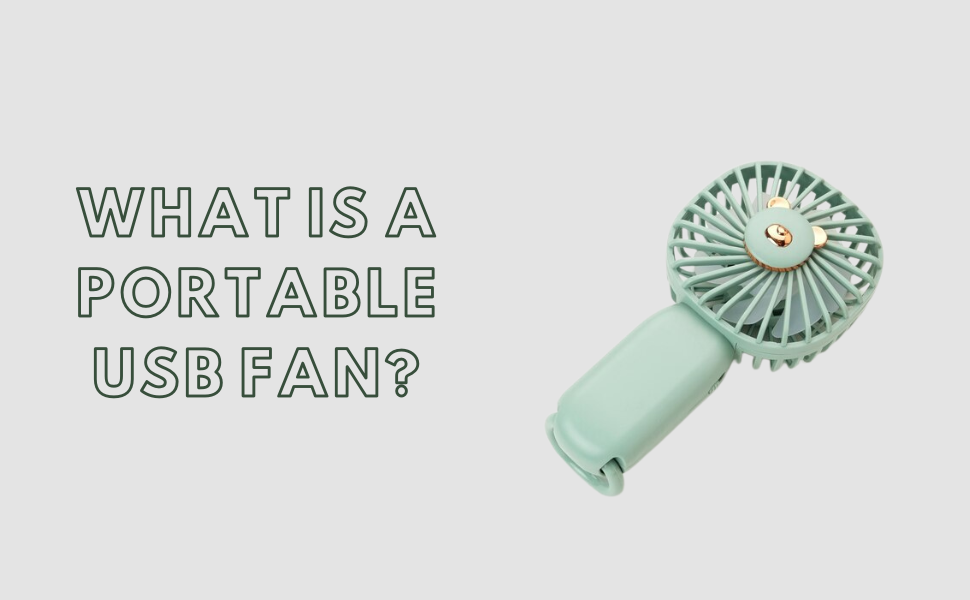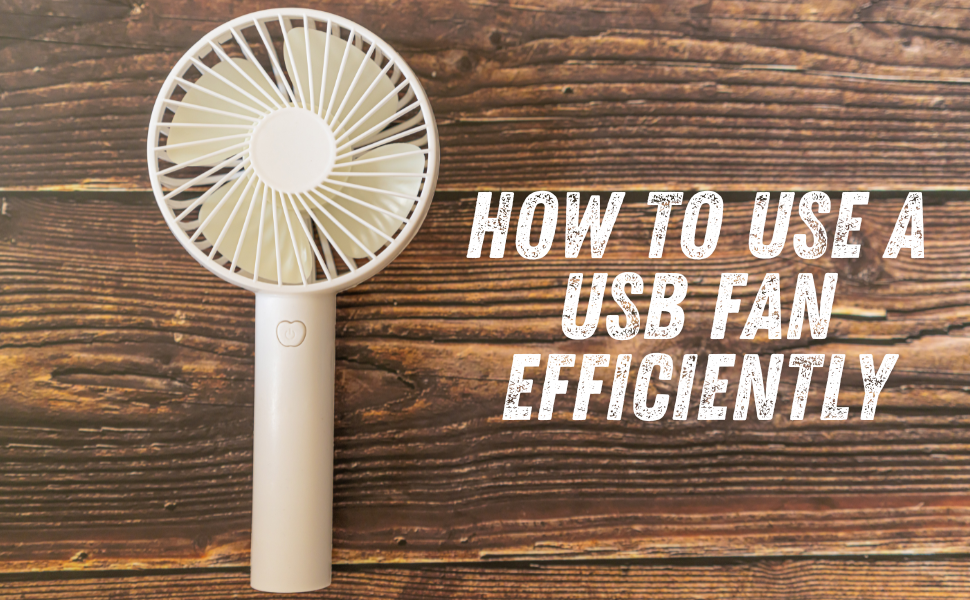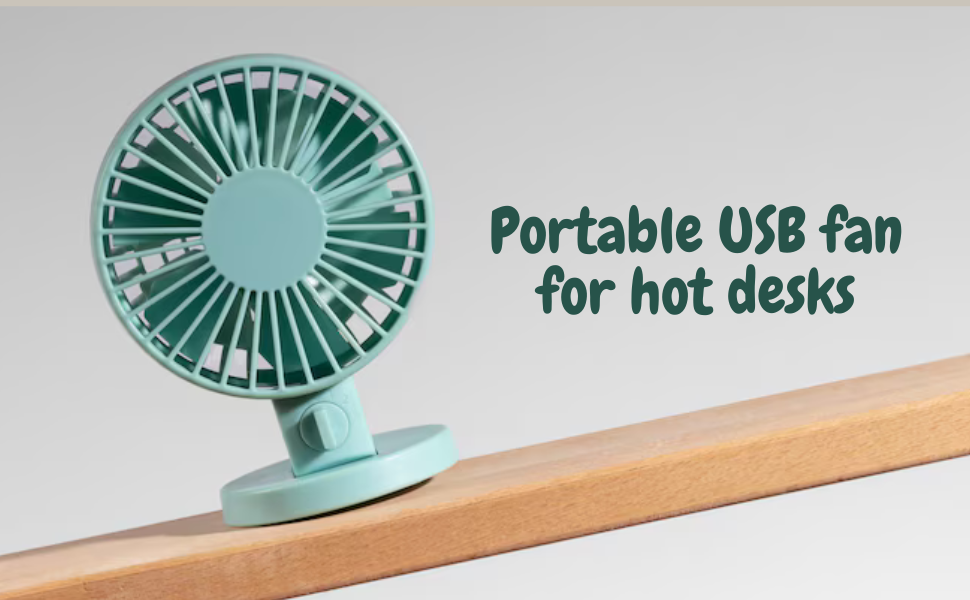The modern workplace has evolved significantly in recent years, with traditional fixed-desk setups giving way to more flexible, dynamic arrangements. One of the most notable trends in this shift is the rise of hot desking—a system where employees do not have assigned desks but rather use any available workspace. While this flexibility increases collaboration and reduces overhead costs, it also presents a unique set of challenges, particularly when it comes to personal comfort. Air conditioning in large office spaces is often centralized and not customizable per user, leading many to feel too warm or uncomfortable during work hours. This is where portable USB fan for hot desks become a game changer. Compact, efficient, and easy to power, these fans provide a simple yet effective way to maintain a comfortable working environment, even in shared or transient workspaces.
In this comprehensive guide, we’ll explore the advantages, types, features, buying tips, and practical uses of portable USB fans designed specifically for hot desks.
What is a Portable USB Fan?

A portable USB fan is a small, lightweight fan powered by a USB port—typically from a laptop, power bank, or USB wall adapter. These fans are built for mobility and convenience, making them ideal for personal use in a variety of settings including hot desks, remote offices, libraries, and even outdoor workspaces.
Most portable USB fans come with adjustable fan speeds, tilting heads, and minimal noise output, making them an excellent choice for shared environments where silence and space efficiency are crucial.
Benefits of Portable USB Fans at Hot Desks
1. Custom Comfort
In a hot-desk environment, you cannot always control where you sit or how the central air conditioning affects that area. A portable USB fan gives you personal climate control, allowing you to cool down your immediate space.
2. Energy Efficiency
USB fans are low-powered devices that consume significantly less electricity than traditional desk or floor fans. They provide adequate cooling while keeping your energy footprint—and electricity bill—low.
3. Portability and Convenience
Weighing only a few hundred grams and often smaller than a coffee mug, these fans can easily be carried in a backpack, handbag, or even a laptop case. You can take them wherever you go, ensuring comfort whether you’re at your usual desk, a co-working space, or a café.
4. USB Compatibility
One of the standout features is universal compatibility with any device that has a USB port. This includes laptops, desktop computers, power banks, USB wall chargers, and even some car ports.
5. Quiet Operation
Most modern USB fans are designed to run quietly, producing noise levels under 40 dB, making them suitable for environments where concentration is key—like offices, libraries, or study rooms.
6. Low Maintenance
These fans are usually simple in construction with fewer mechanical parts. That means less maintenance and fewer breakdowns, making them a long-lasting investment.
Key Features to Look For
1. Adjustable Fan Speed
Many fans come with multiple speed settings—typically low, medium, and high. This allows you to adjust the intensity of the airflow based on the temperature and your comfort needs.
2. Tiltable or Rotatable Head
Look for models that allow 360-degree rotation or at least vertical tilt. This flexibility ensures that you can direct the airflow exactly where it’s needed without having to reposition the entire unit.
3. Power Options
There are two main types:
- Plug-in USB fans: These draw power directly from a USB port.
- Rechargeable USB fans: These come with built-in batteries and can run wirelessly after being charged.
If you’re constantly on the move or working remotely, a rechargeable fan is often the better choice.
4. Battery Life
For battery-operated fans, check the battery capacity (mAh). A 2000–4000 mAh battery can typically run 4 to 8 hours depending on speed settings.
5. Noise Level
Measured in decibels (dB), quieter fans usually operate between 20–40 dB. If you work in quiet environments or dislike distracting noises, choose a fan designed for silent or whisper-quiet operation.
6. Build Quality and Materials
Durable plastics and non-slip rubber bases are standard. Some premium models feature metal grilles or alloy bodies, which enhance longevity and aesthetics.
7. Additional Features
- LED Lighting: Great for night use or ambiance.
- Aromatherapy diffuser: Some fans allow you to insert aroma pads for a pleasant workspace scent.
- Clip-on function: Useful for attaching to shelves, monitor edges, or cubicle walls.
Top Use Cases for USB Fans
1. In the Office
Whether you’re hot-desking or using a co-working space, USB fans provide personalized cooling where you can’t control the thermostat.
2. Remote Work / Home Office
If you work from home, especially during summer months, a USB fan can help reduce reliance on air conditioning, saving on energy costs.
3. Travel and Commutes
Compact enough to fit in your bag, portable USB fans can make long train rides, bus commutes, or hotel stays far more comfortable.
4. Outdoor Working
For those working on patios, in cafes, or on-the-go, a USB fan with a built-in battery offers cooling without needing a power outlet.
How to Use a USB Fan Efficiently

1. Choose the Right Spot
Position your fan so it directs airflow across your face or upper body. Avoid blowing directly into your eyes, which can cause dryness.
2. Clean Regularly
Dust buildup can reduce efficiency. Clean the fan blades and grills every couple of weeks with a dry cloth or small brush.
3. Use Power Banks Strategically
If your fan is USB-powered but not rechargeable, pairing it with a 10,000+ mAh power bank can extend its usability throughout the day.
4. Monitor Battery Usage
Turn the fan off when not in use to conserve battery, especially during lunch breaks or long meetings.
Best Portable USB Fan Brands
Here are a few reliable brands known for high-quality portable USB fans:
- Opolar – Known for powerful fans with long battery life.
- Honeywell – Offers compact, efficient models with a good balance of noise and airflow.
- EasyAcc – Offers multi-functional fans with clip-on bases and built-in lights.
- Jisulife – Combines modern design with excellent battery performance.
- VersionTECH. – Popular for multi-angle adjustment and dual power options.
Environmental and Health Considerations
1. Air Circulation Improves Productivity
Good air circulation reduces drowsiness and helps maintain alertness, especially during long working hours.
2. Reduces Eye Strain and Skin Dryness
Unlike strong AC drafts, personal fans produce a gentler breeze, reducing the risk of dry eyes and irritated skin.
3. Eco-Friendly Option
By reducing reliance on centralized cooling systems, USB fans contribute to lower energy consumption and carbon footprint.
Conclusion
As modern workspaces continue to evolve, the demand for portable, personal comfort solutions is on the rise. Portable USB fans fit perfectly into the new landscape of hot desking and flexible working. Their compact size, ease of use, quiet operation, and energy efficiency make them an ideal companion for any professional on the go.
Whether you’re navigating the unpredictability of co-working spaces or simply looking for a reliable cooling device for your home office, a portable USB fan is an affordable and practical investment. By understanding the key features and how to use them effectively, you can ensure a more comfortable and productive workday—no matter where you set up shop.
FAQs
Q1: Can I use a USB fan without a laptop or computer?
Yes! USB fans can be powered by USB wall adapters, power banks, or even USB ports in cars.
Q2: Are USB fans strong enough to cool an entire room?
No, USB fans are designed for personal cooling only. They are best used in close proximity, such as on a desk or bedside table.
Q3: Do USB fans consume a lot of power?
Not at all. They typically consume between 2.5W and 5W, making them extremely energy-efficient.
Q4: Can I travel with a USB fan on an airplane?
Yes, USB fans are generally allowed in carry-on luggage. However, check airline regulations if the fan includes a built-in lithium battery.
Q5: How do I clean a portable USB fan?
Turn off and unplug the fan, then use a soft brush or cloth to remove dust from the blades and grill. Some models have removable fronts for easier cleaning.

